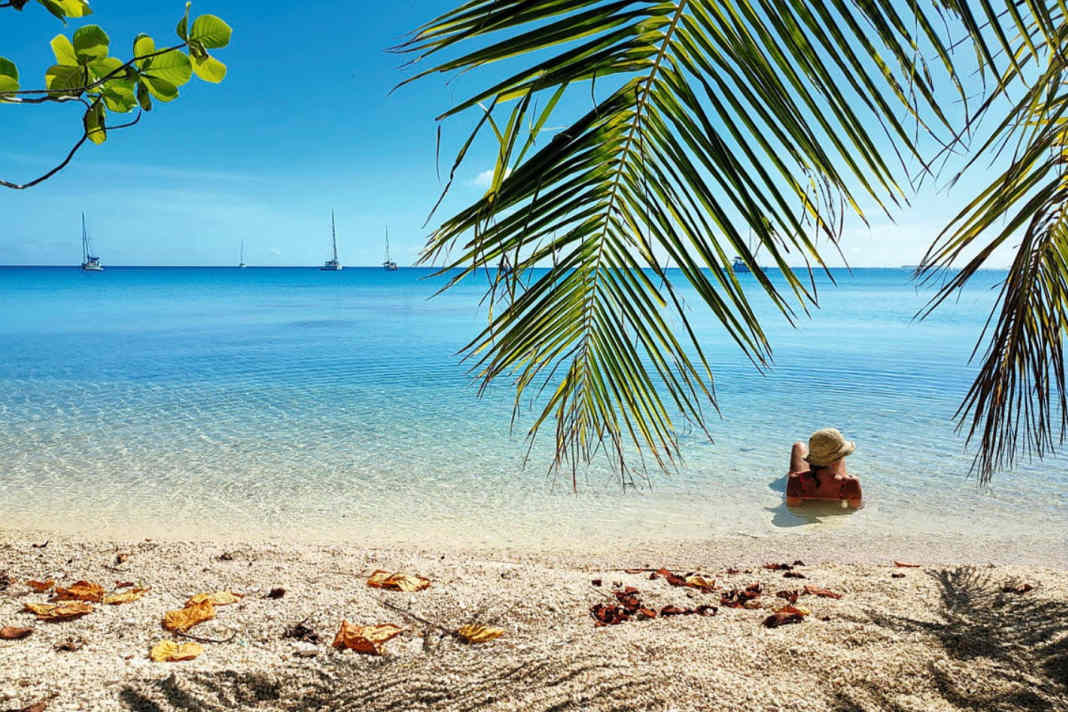





Text: Franz Schmitt
Part 2 of the cruise report you can find here!
Anyone who sails in the Tuamotus has come a long way. These paradisiacal island atolls in the middle of the Pacific are almost on the other side of the world - at least for us Europeans. Almost all the sailors you meet here are travelling on their own keel and have already covered a huge number of nautical miles. It's the same for us. We have set course from the Marquesas to the Tuamotus.
Two million square kilometres
"We" are Mareike, Franz and "Holly Golightly", a Nordbord 33 from 1986. The first two are from Braunschweig and set off on a long blue water cruise in the Schlei from their home jetty at Henningsen & Steckmest in 2022.
If you suffer from a fear of heights, the Tuamotu archipelago is the perfect place for you. It could hardly be shallower: the atolls, some of which are vast, rise a maximum of six metres out of the sea. However, most of them are largely submerged. There are 76 in total, spread over two million square kilometres of ocean. That is equivalent to the area of Western Europe. The dry parts of the atolls, also known as motus, are just the size of Berlin. 17,000 people live here.
Arrival on Tuamotu: Raroia
Due to countless reefs and strong currents, the Tuamotus are one of the most dangerous places in the world from a nautical point of view. It is not for nothing that they used to be called the "Dangerous Islands". Thanks to GPS, better nautical charts and more accurate weather forecasts, sailing has become much safer today.
After our farewell to the Marquesas, an uncomfortable upwind course, three metre waves and squalls with plenty of rain await us. But on the morning of the third day, shaken and stirred, we reach Raroia, Tuamotu's largest atoll.
In the right place at the right time
What makes entering the interior of an atoll exciting are the tides, currents and wind - similar to the Seegatts between the East Frisian Islands. The best moment is the so-called slack time, the slack water between low and high tide. At other times, the current in the passages is sometimes so strong that standing waves form and passage becomes impossible. The same applies in strong winds. So make sure you are in the right place at the right time!
Unfortunately, we arrive at the Raroia pass just under an hour after slack time. When we reach the entrance, we don't really trust the whole thing. We chug back and forth waiting to see how the water flows out of the lagoon like a wide, raging river.
With two knots over ground
Then we receive a radio message from a yacht in the atoll. The crew had observed our AIS signal and told us to be brave. So "Holly Golightly" accelerates hard and takes off. True to the Cologne motto "Et hätt noch emmer joot jejange", we throw ourselves full throttle into the impressive counter-current and slowly fight our way forwards with barely two knots of speed over the ground. But five minutes later we are in the atoll and breathe a sigh of relief - we have made our first reef passage!
The best anchorage inside is on the opposite side of the lagoon. At the bow, Mareike uses eyeball navigation to keep an eye out for obstacles, which she confidently navigates around. Thanks to the high sun, the countless coral reefs are easy to spot. After six nautical miles, we drop our anchor next to other yachts in the clear blue water.
Thor Heyerdahl has also been here
Thor Heyerdahl also passed by here a long time ago. In 1947, he spectacularly stranded his "Kon-Tiki" on the outer reef not far from our anchorage. Today, a small memorial commemorates his courageous journey on the balsa wood raft. However, his theory that Polynesia was colonised from South America later turned out to be largely false.
We are joined by seven to eight other sailing yachts in the east of the atoll. We know most of them by now, as we have met them here and there several times. It's a bit like being in a small village. Radio calls are used to make appointments for sundowners or to coordinate a trip to the Heyerdahl monument. As we unfortunately don't have a working outboard motor at the moment, someone always gives us a lift - a real community here in Tuamotu!
Continue to Fakarava Atoll
The crew of the "Sail la vie", who had already generously given us fish in Fatu-Hiva, then radioed us because they needed rum. We donate a small bottle and are offered four fresh salad leaves and a tomato in return. It's hard to believe, but we celebrate the tomato the most - fresh vegetables are in short supply here.
Days later, we set off for Fakarava, an even larger atoll. In order to arrive there at slack time in the morning, we sail overnight. The conditions are so good that we have to constantly slow down with the genoa reefed so that we don't reach our destination too early. We reach the southern pass early in the morning and this time we have it easy: our friends Verena and Tim with their "Moana" from Kiel sail ahead. We watch what happens and then follow inconspicuously. We anchor directly behind the entrance to the pass in front of the village of Tetamanu and rest for a while.
Part 2 of the cruise report you can find here!

